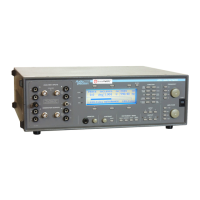Selecting Bandwidth
Selection of a bandwidth-limiting filter is often of critical importance in
THD+N measurements. This is mainly for two reasons:
.
Noise exists at every frequency. The wider the bandwidth of the
measurement, the more noise is included.
.
Limiting the bandwidth can eliminate other components, which
you may or may not want included in the measurement.
The amount of noise included in the measurement will be directly
related to the bandwidth. If you are more concerned with distortion
and interference products than noise, it is wise to set the upper band
limit to allow the highest component of interest but reject noise above
that frequency. Most mechanisms that create harmonic distortion
concentrate most of the distortion in the second and third multiples
(harmonics) of the fundamental. Therefore, for most devices it is
reasonable to limit the bandwidth to around four times the highest
fundamental frequency of interest.
It is most common to limit the bandwidth to 80 kHz, since this will
reject high-frequency noise while passing the second and third
harmonics of signals up to 22 kHz, the top of the audible frequency
range.
You may want to limit the lower band limit to remove hum from the
measurement. Using the 400 Hz highpass filter will eliminate the hum
products while passing all fundamentals, interference, distortion
products, and noise above 400 Hz.
Following is an example of the use of various bandwidth-limiting
filters. The spectrum of the original signal may look like this:
20 50 100 200 500 1k 2k 5k 10k 20k 50k
Hz
-140
+20
-120
-100
-80
-60
-40
-20
+0
d
B
r
A
200k100k 300k
Understanding THD + N FUNCTION Descriptions
4 Functions
4-14 ATS-1 Access User's Manual

